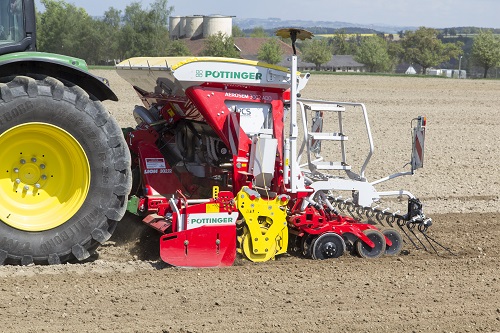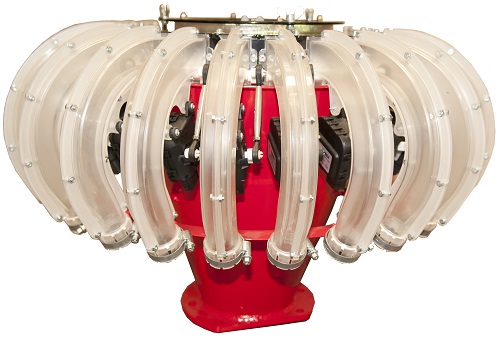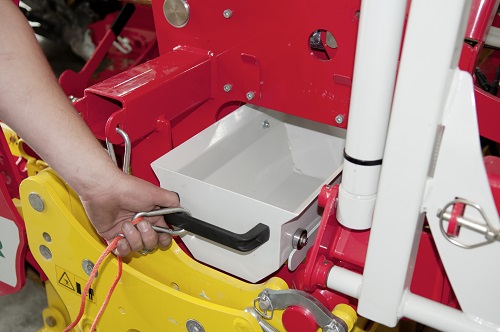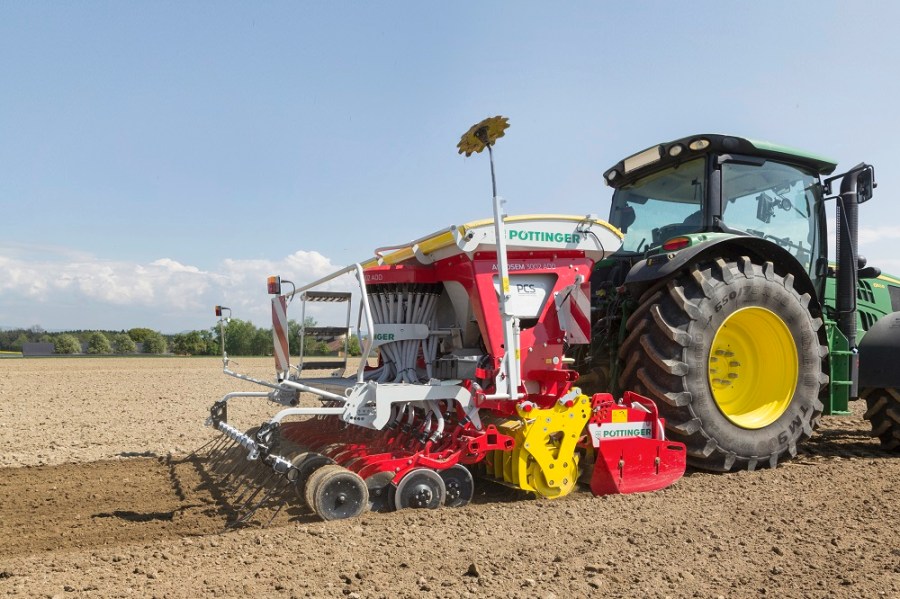Worcs-based Harper Farming chose a Pöttinger Aerosem drill to manage its move across a broader range of vegetable and salad crops. CPM visits to find out how the first season has progressed.
The longer we looked at it, the more we came to the conclusion that it was a very well thought-out job.
By David Jones
Towards the end of 2016, it was becoming increasingly clear to John Harper that he was going to need another drill. The cropping planned for this year at Woodside Farm, Holt Heath, near Worcester, included an increase in the range of vegetables and salad types grown, and he wasn’t certain that the machine he had at the time could handle the range of seed sizes.

The Aerosem drill working in conjunction with the Lion power harrow soon after they were delivered to Harper Farming earlier this year.
“It came down to the fact that we needed to replace the existing box drill, which we’d only run for a couple of years,” John reports. “The big increase in the number of herb varieties that we’d introduced during that period meant that a trailed drill was no longer really an option. What we actually needed was a small disc drill with a metering system that we could fine tune to suit our specific needs.
“We’d been looking at both a precision drill and a combination drill, but I really didn’t want to have to buy one of each. Having grown sweet corn as well in the past, there was a stage when we could have done with a range of drills, all with different specific jobs.”
Irrigation requirement
The business, Harper Farming, extends to 400ha, most of it around the village of Holt Heath, four miles to the north of Worcester. Much of the land farmed is sufficiently close to the River Severn to allow abstraction – an essential facility in a dry spring year like this one, with a high proportion of the cropping requiring irrigation to varying degrees.
The soils are predominantly river silts and river terrace sands that provide an ideal environment in which to grow vegetable and salad crops. Cereal production here currently consists of wheat and oats, which between them extend to around 60ha in a typical year.

The newly developed Intelligent Distribution System controls all the machine outlets via the BUS system.
The rest of the cropped land is grown with a broad range of vegetable and salad crops (see panel below), while the balance of the farmed area is down to grass and supports a breeding herd of 50 Hereford suckler cows and a flock of 350 Welsh mules. A large proportion of the meat produced is sold through the farm shop.
Resolved to address the drill dilemma, John and his foreman subsequently travelled east across the country to inspect and assess one particular model at a dealership. “On the way, I was looking at details of possible replacements and happened to come across the Pöttinger website on my phone,” John recalls.
On closer examination, John’s interest was heightened when he saw that the company builds a precision combination drill of the type and specification he was looking for. So much so that he decided to make a call to James Green Machinery, near Studley, Warwicks, and arranged to drop in on the way back to find out more.
Precision module
A week later, John and his foreman were heading east again, this time to Pöttinger’s UK head office at Corby and were pleased to discover that not only was there a model on which the rows and coulters can shut be off, but also that the company makes a precision module that can be fitted to handle maize.
As it turned out, though, he ended up going for the version that allows the valves to be shut off. “The longer we looked at it, the more we came to the conclusion that it was a very well thought-out job – it seemed to have everything we were looking for in a drill, whereas the others we had seen were a bit hit and miss,” he notes.

The calibration system is fitted with a catch pan for ease of use and saving time. The flap is monitored by a sensor.
Two Pöttinger machines were duly purchased in March this year – a Lion 3002 power harrow is run in front of an Aerosem 3002 ADD drill. Seedbed preparation and planting for the salad and vegetable crops is carried out using a bed-former.
Now it’s been trialled across the cropped enterprises, it’s received the thumbs up from farm agronomist John Vickery of Agrii, who provides guidance on the vegetable side of the operation, and Frontier’s David Allison on the cereal-growing side.
John Vickery is impressed by how well some of the crops have established with the new Pöttinger set-up. “The speed of crop development has been very good, even though there wasn’t a great deal of rain coming down at the time,” he reports.
“In the case of the spinach and coriander, it allowed us to drill into moisture, which gave it a good start and without the need for a precision drill.”
Complementary to the vegetable and salad thrust of Harper Farming are crops of winter wheat, spring oats, spring barley and fodder beet, with the addition this year – for the first time – of oilseed rape.
“Our challenges here are based very much around the diversity of the cropping overall,” David comments. “The vegetable and salad part of the business comes first, so timing is the main issue to deal with – cereals are regarded as break crops for the farm overall. That means getting them drilled and sprayed on time depends largely on where we are with the farm’s cash crops.”
While power on the farm is provided predominantly by a fleet of New Holland tractors, supplied and maintained by the Murley’s dealership at nearby Stourport, There’s also a 24m self-propelled Agri-Buggy sprayer. But the farm doesn’t have a combine harvester and relies on a local contractor for cereal harvest.
With the combinable crops side invariably coming second, David advocates following a policy of integrated pest management, selecting varieties with good disease resistance and with a low risk of lodging – the latter being important due to the high availability of soil nitrogen following the vegetable crops.
“We look to use residual herbicides for weed control, together with a full fungicide and plant growth regulator programme to add insurance,” he says. “We know from experience that workload and weather pressures will almost certainly compromise spray timings.
“More recently, we’ve started to use cover crops in the rotation, particularly oil radish, after spring onions, in order to catch nitrogen and improve soil structure.”
The Aerosem, John believes, gives the impression that it’ll last, and the attention to detail is quite apparent. “If you look at how the pre-emergence markers have been designed, for example, you’ll see that they have the facility to be folded right out of the way – we had a contractor here a couple of years ago who reversed into a hedge and bent them right off,” he states.
“The calibration system is fantastic – it’s automatic, so you can set it from the cab. And the fact that it can also handle small seed with great accuracy means we have the flexibility to extend the range of herbs that we’re growing now and allows us to switch over to new varieties whenever we want to. With some drills that we’ve used in the past this can be one heck of a job – and the seed hopper is self-cleaning, which is a big help.
“I have to admit, though, that we’re probably not a drill manufacturer’s typical customer!”
Versatility virtue of Aerosem drill
One of the main reasons John went for the Aerosem was because of the IDS (Intelligent Distribution System) head, Pöttinger’s Rodney Dingle recalls. “This allows the user to do a number of things,” he explains.
“Probably the most important of these is that it gives him the ability to drill beans at 37cm just by pressing a few buttons on the controller. It also enables him to switch between seeds very simply – which is particularly useful when he’s drilling so many different crops each week.
“The IDS System was awarded a silver medal at Agrictechnica when it was first introduced, and controls all the outlets via the BUS system,” he continues. “This opens up many capabilities in seed row and tramline switching, in conjunction with Power Control or ISOBUS on the tractor and the electric metering drive.”
The operator can select between row spacing, tramline and track widths, tramline switching, dual tramlines and half rail switching, left and right. The IDS controls automatic seed flow reduction in the metering system when tramlining and half rail drilling, with excess seed being returned to the riser tube via the funnel system.
“What this means is that there’s a consistent number of seeds in each row, the crop develops uniformly and savings in seed use of up to 6% can be achieved.”
According to Rodney, dual disc coulters represent the option most commonly specified by users of Aerosem drills in the UK, with a 12.5cm coulter spacing. “Spacing had been an issue on many drills in the past, so particular attention was given to this area at the design stage.
“Providing up to 50kg of coulter pressure, the Dual Disc coulters are offset, with one disc leading the other by 25mm. This means that 40% less draft is required than with conventional double discs positioned together.
“The seed delivery pipe is mounted in the enclosed front zone of each pair of discs and uses the discs’ rotary action to place seed accurately into the slot. These cutting-edge parts are kept clean by carbon-edged scrapers and sealed hub bearings mean that the area surrounding the coulters is maintenance-free,” he explains.
A feature of the Aerosem drill is the vertical hydraulic-fold bout markers – which incorporate rear-mounted, pre-emergence markers – while a wide loading platform permits easy access to the hopper. Single point metering can be shut off independently of the main hopper by means of a straightforward guillotine plate, so that seed wheel changes can still be made when the hopper is full.
The Lion 3002 power harrow – a model that has been in production for more than 40 years – features a robust taper roller bearing construction, with a trough that uses semi-liquid grease for machine lubrication. Large diameter gears drive rotor shafts that support quick change heads and heavy duty 18 x 320mm tines.
Cropping fits into a diverse picture
Around 2% of crop production and a large proportion of the farm’s meat is sold through the company’s Top Barn farm shop. The site also accommodates a substantial, multi-tenanted business park, fishing lakes and, until recently, a water sports centre on land that has since been sold to the nearby University of Worcester.
The various elements are run as independent businesses by members of the Harper family – David and Diana, their daughter and three sons – and it’s one of these, John, who owns and manages the farming and packing operations.
The rest of the crops are destined for supermarkets throughout the country, via the on-site pack house – itself a joint venture with specialist wholesaler Minor Weir Willis (MWW).
With its origins in Birmingham’s Smithfield wholesale fruit, vegetable and salad market MWW has been in existence for more 50 years. The company is now one of the UK’s biggest suppliers to supermarkets, with an offer of more than 100 fresh product varieties from around 60 countries.
The MWW Group now has companies in Holland, Spain and Germany, while its most recent set of accounts showed annual turnover in excess of £160 million for the UK business alone.
The MWW name has become more widely known in more recent times as a result of the company’s support of the Government’s ‘Five-a-day’ initiative, providing fresh fruit to schools.
Farm Facts
Woodside Farm, Top Barn, Holt Heath, Worcester.
- Area farmed: 405ha
- Soil types: River silts, river terrace sands (water abstracted from the nearby Severn)
- Cropping: Winter wheat, spring oats, spring onions, green beans, runner beans, broad beans, flat beans, peas, sugar snap peas, pak choi, chinese leaves, spinach, coriander, squashes, rainbow chard (spinach and coriander between them accounted for 120ha this year)
- Staff: Four during winter months, rising to 90+ during picking season.
- Mainline tractors: New Holland 7225, NH 6070, NH 5060, NH 140
- Drill: – Pöttinger Aerosem 3002 ADD
- Power Harrow: – Pöttinger Lion 3002
- Sprayer: 24m Agri-buggy
- Livestock: 50 Hereford suckler cows, 350-strong Welsh mule flock
- Other enterprises: Farm shop, multi-tenanted business centre, fishing lakes.




